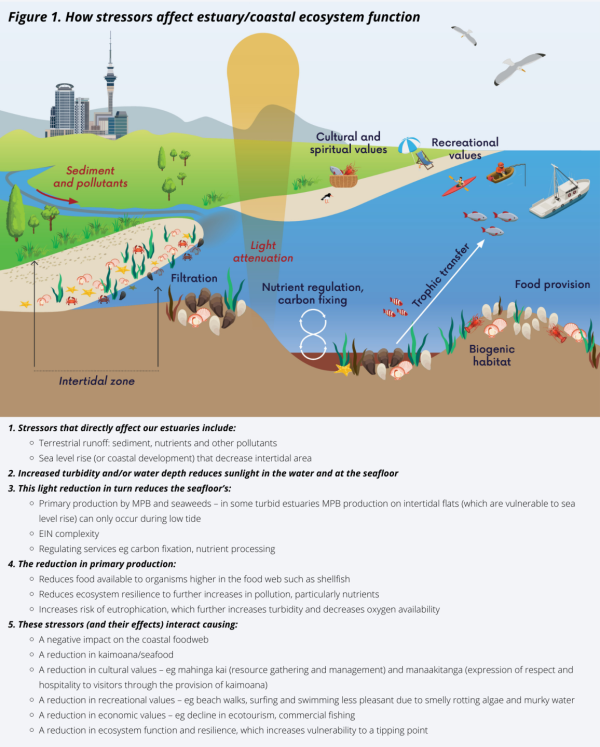- Summary
Putting research into action to manage estuaries
This impact case study describes how estuary guidance created by our research is supporting marine managers, and decision-makers (August 2021)
Estuaries are some of our most productive ecosystems and are where many New Zealanders work, live and play. They are affected by stressors from both land and sea, which makes managing them especially complex. In addition, decision makers have limited tools and information to help inform which management actions will be most effective.
Our Tipping Points project was a national-scale experiment investigating the impact of key stressors on our estuaries: nutrients, sediment and projected sea-level rise. Light availability in the water column and at the seafloor plays a critical role in ecological processes that underpin the delivery of vital ecosystem services.
Research findings
- A better understanding of how turbidity in estuaries interacts with elevated nutrients to alter ecological interaction networks (Figure 1).
- New knowledge of how the loss of intertidal areas due to future sea level rise in turbid estuaries will substantially reduce seafloor primary production that fuels coastal foodwebs (Figure 1).
- The resulting vulnerability of different estuaries to a tipping point (Figure 2).
- Stressor interactions do not play out in the same way everywhere, meaning that national scale set limits will not be effective because local context is critical (Figure 2).
Research that everyone can access
With limit setting and estuaries being brought into the National policy statement on freshwater (NPSF) it is critical to get this research to the people who need it now. The findings are available in high impact peer-reviewed journals. However, journals are not the most accessible or practical format for marine and consent managers, kaitiaki, policy advisors, and coastal planners.
To support timely take-up of these findings and recommendations we have worked with co-developers and users to:
‘Translate’ findings into user-focused guidance and summaries
- Managing the impact of turbidity, nutrients and sea level rise on coasts and estuaries (4-page guidance)
- Tools and resources for marine managers (12-page summary ‘catalogue’ of relevant research outputs)
“[The guidance] is definitely a great way to present the scientific material from the papers produced. The language is great to be able to share around non-specialist parties. The recommendations section is really helpful – gives us direction and backing to head towards these management strategies.” - Josie Crawshaw, Coastal Scientist, Bay of Plenty Regional Council
Identify the best way to deliver them
- Council Roadshow – Following multiple requests from council co-developers, we ran 1-day workshops with Environment Canterbury, Auckland Council, and Bay of Plenty Regional Council. We co-developed the agendas with council staff. Multiple councils have requested a workshop in 2021/22.
- Attendee said: The workshop has helped them access information and resources relevant to their job; better understand how our research is relevant to their work; that the “guidance documents are really well received”, with the information being relevant and presented in a useful way.
- C-SIG presentation – The Leadership Team presented relevant research to representatives of all regional and district councils at the Coastal Special Interest Group (C-SIG). This resulted in a request for a webinar (see below).
- Webinar on the problem of turbidity in estuaries – to assist councils with limit setting exercises as they grapple with the inclusion of estuaries in the NPSF and managing cumulative effects from land-based stressors. This was co-presented with Megan Carbines (Auckland Council), and well attended by staff from regional/district councils, as well as central government and research organisations.
Who’s involved
This work has had Māori partner and stakeholder input from the beginning. The Tipping Points project began with hui with several councils and iwi groups. The ‘translation and delivery’ work has been a co-developed process involving end-users at each stage. The team that did the empirical fieldwork spanned six academic, CRI, and research organisations.
Contact
Conrad Pilditch [email protected]
Research organisations
University of Auckland, University of Waikato, NIWA, University of Canterbury, University of Otago, Cawthron

